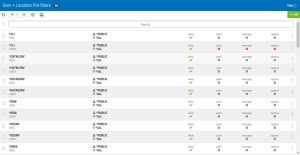How to Get There
Click the User+Location tab on the navigation pane on the left side of the Network Security window.
What it Does
The User+Location Pre-filters screen allows you to specify certain actions for transactions before they are evaluated by the regular Powertech Network Security rules. The primary action is to allow or not allow a transaction — allowing it causes it to be further evaluated by Network Security rules; not allowing it is equivalent to a Network Security reject. The other actions that you can specify are to audit the transaction, send an immediate message, and capture the transaction. These actions work exactly like their equivalents within Network Security rules processing. The Location + User Pre-filter function allows you to specify settings by function, location, and user. These records can be changed but not deleted. System record must have either a 'Y' or an 'N' for each of the settings (allow, audit, message, and capture).
The Pre-filter function attempts to match the most specific record to the transaction. Once a match is found, the Pre-filter function processes the transaction based on those settings.
Options
Selection, sorting, filtering, deleting, and navigation features on this screen are described in Using the Web Browser Interface. Click a Pre-filter to open the Edit Location + User Pre-filter screen where you can edit the Pre-filter.
Add
Choose Add to open the New Location + User Pre-filters screen where you can define a new User+Location Pre-filter.
Field Descriptions
Server > Function column
This column lists the server and function IDs for each Pre-filter. For a description of servers and functions, see Appendix B: Servers and Functions.
Location/User/User Group Column
This column lists the location of the Pre-filter. The location is the name of the location for which authority is being specified. The location can be an SNA device, an IP address, an IP Address Group, or the special value '*ALL'. If specifging an IP address, enter either the full IP address or a generic IP address using an asterisk as the final character. IP Address Groups must be established prior to their entry on this screen (see IP Address Groups).
User represents the identity of the person initiating a transaction as a user profile. The special value *PUBLIC, when used on a Pre-filter, means that the Pre-filter applies to any User lacking a specific Pre-filter.
Allow
The setting for whether transactions matching this record should be allowed to continue to be processed by Network Security. Valid settings are 'Y' (Yes — Network Security rules should evaluate this transaction, which may or may not cause it to be rejected, 'N' (No — reject the transaction), and a gray Y or N (inherit the value from the System (*ALL) Pre-filter).
Aud/Msg/Cap columns
A  or
or  in one of these columns indicates the value is explicitly defined in the rule. A gray
in one of these columns indicates the value is explicitly defined in the rule. A gray  or
or  indicates the value is not defined in the Pre-filter itself, but is inheriting the actual value from the default System Pre-filter (*ALL). See Active Rule and Rule derivation.
indicates the value is not defined in the Pre-filter itself, but is inheriting the actual value from the default System Pre-filter (*ALL). See Active Rule and Rule derivation.
Audit
The audit property controls the type of requests Network Security will log. Possible values are:
Message
The message property entry will determine if Network Security sends a message to the Network Security message queue.
Capture
Capture transactions for Memorized Transaction Request (MTR).
